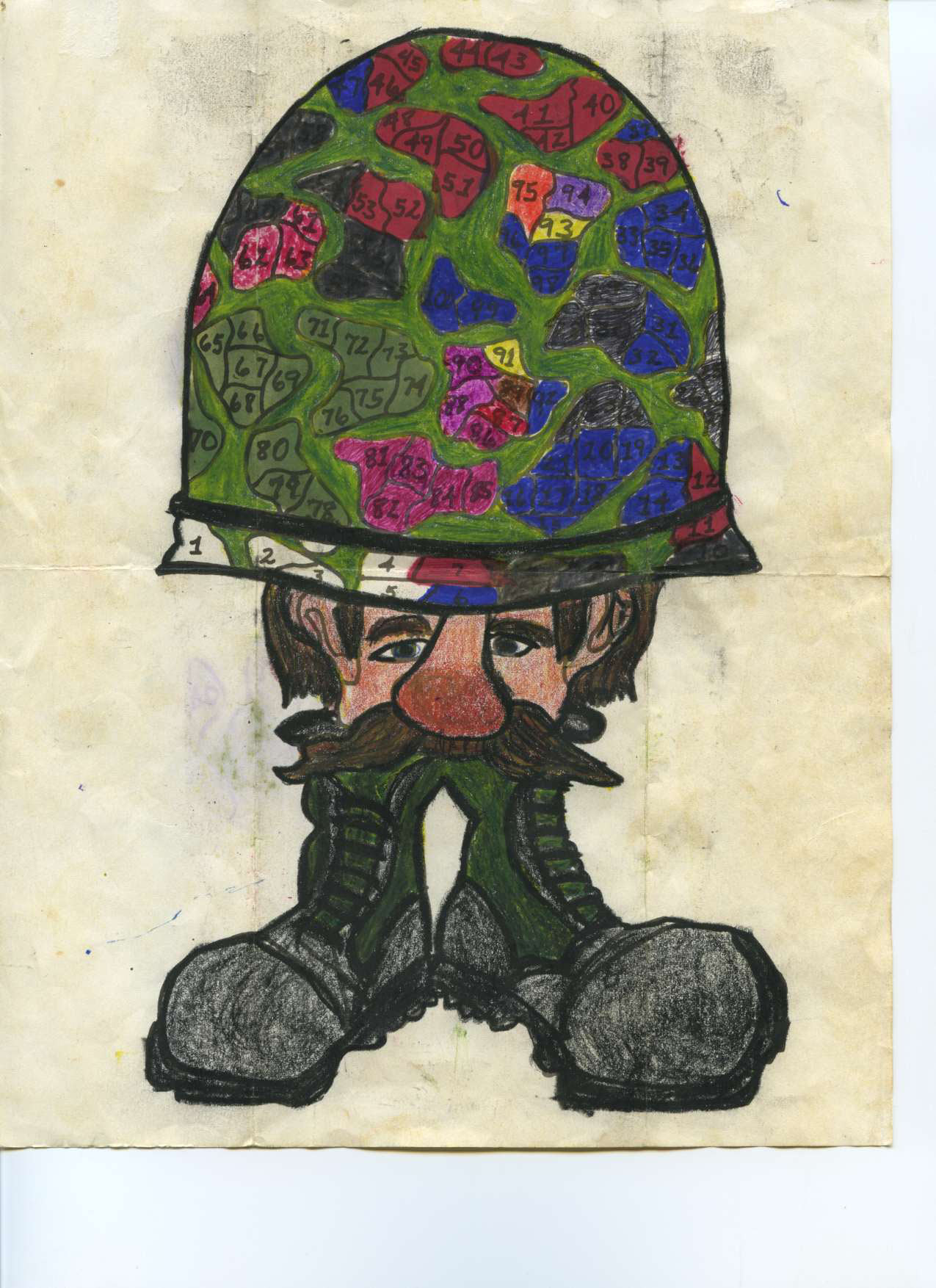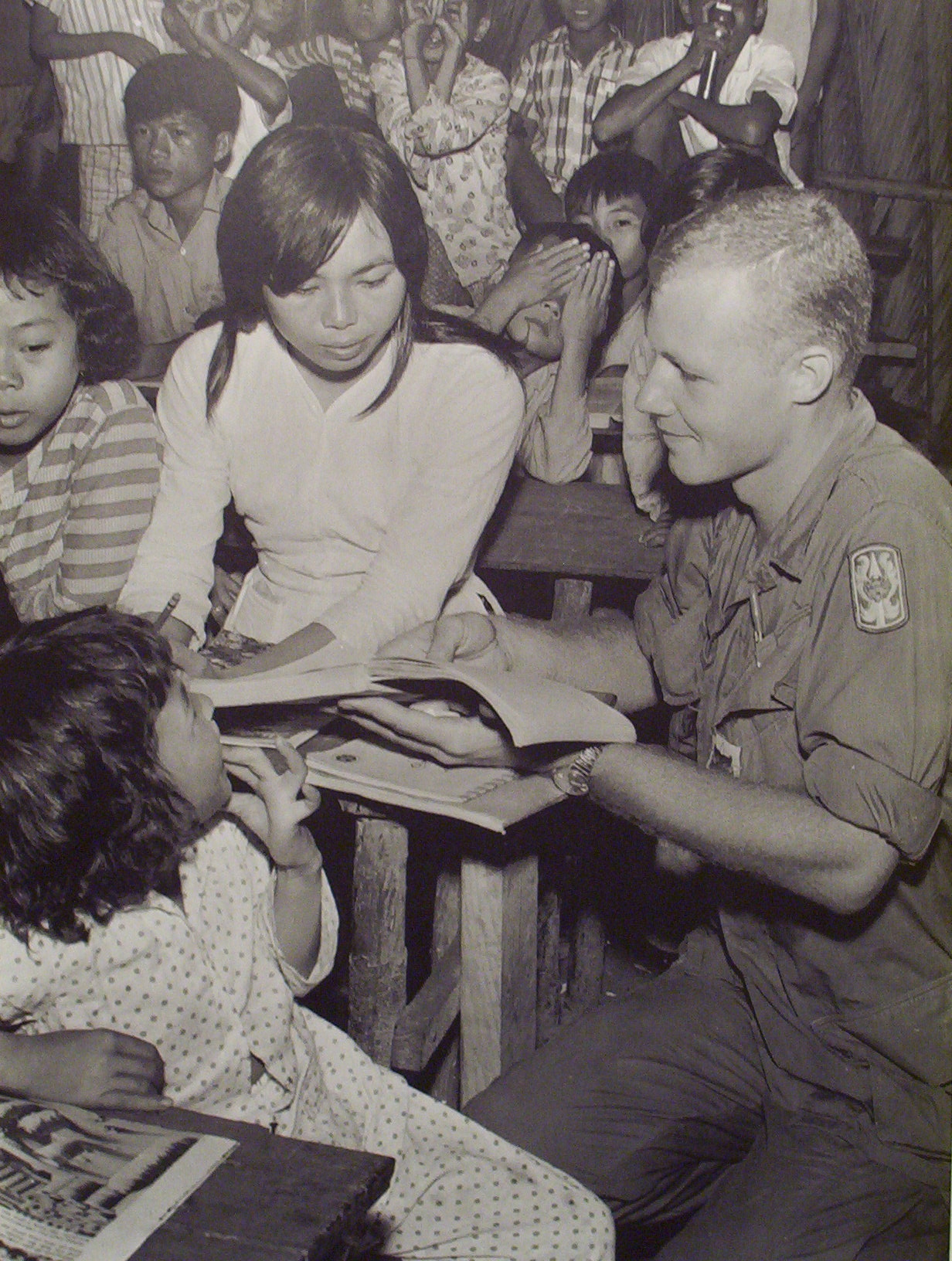

A Grunt’s Primer:
Terms and Slang Commonly Used By Military Personnel in Vietnam/Cambodia
ACAV: Armored Cavalry Assault Vehicle used by mechanized and armor units such as the 11th Armored Cavalry Regiment. These were usually M113 armored personnel carriers modified with M60 and .50 caliber machine guns.
AIRMOBILE: Soldiers and material delivered by helicopter.
AIR CAVALRY: Infantrymen carried into battle by helicopters. This term is usually associated with the 1st Air Cavalry Division.
AK-47: The basic infantry weapon carried by the North Vietnamese and Viet Cong soldier. The weapon fired a 7.62x39mm round on either semi or full automatic. It was hard-hitting, very reliable and made a distinct sound when fired.
AO: Area of Operations. This is where a combat unit is operating in the field to find and engage the enemy.
ARC-LIGHT: Code name for a B-52 Strato-fortress air strike. It was absolutely devastating for anything miles around. The plane could carry eighty-four 500 lbs. bombs inside and twenty-four 750 lbs. bombs outside that were mounted on racks. The B-52’s had a range of over 3,000 miles.
ARVN: Army of the Republic of Vietnam. The soldiers the US was supposed to be helping.
BASE CAMP: A field headquarters for a combat unit operating in a specific area of operations. The camps would usually contain all of the unit’s supporting components.
BATTALION: A unit usually commanded by a Lieutenant Colonel. On paper, the US Army battalion was composed of approximately 700-800 personnel. However, because of wounds, sickness, emergencies and too many other reasons to list, the US Army Infantry battalion in operating in Vietnam and Cambodia was usually smaller. Each battalion had four maneuver companies (Alpha, Bravo, Charlie and Delta) and one support/reconnaissance/mortar company (Echo).
BERM: A built-up area, usually of dirt, that surrounded a base camp’s circular perimeter. It offered some protection against incoming enemy rounds.
BIRD: Slang term used to describe most any plane or helicopter.
BMB: Brigade Main Base. Nickname for Camp Frenzell-Jones, the main base for the 199th Light Infantry Brigade while in Vietnam and Cambodia.
BUNKER: A defensive structure built in the field by the already exhausted infantryman, usually around four to five feet deep with overhead cover.
CACHE: Term used to describe a hidden enemy weapons, food or ammunition find.
C & C: Command and Control. C & C oftentimes denoted the commanding officer’s Huey helicopter that orbited the sky over a unit’s position in the field.
CHICOM: Chinese Communist. The acronym means weapons and equipment made in China.
CHINOOK: The CH-47 Helicopter.
CHOPPER: Slick or helicopter.
CLAYMORE: An anti-personnel mine that was utterly devastating and effective when used against infantry soldiers. The US manufactured claymore mine was a little larger than a 6x9 paperback book and spewed out over 700 steel ball bearings in a 65-degree arc. The Communist mines were larger.
CO: Commanding Officer
COBRA: The AH-16 attack helicopter.
COMPANY: Unit commanded by a captain that consists of three platoons or 120 men. Rarely was an infantry company up to full strength in the field in Vietnam and Cambodia.
CONTACT: In contact, in a firefight, or engaged in battle with the enemy.
CP: Command Post. Where the leaders or commanding officers of a unit are oftentimes located.
CPT: Abbreviation for Captain.
DOC: Slang for medics or medical aid-man.
DUSTOFF/MEDEVAC: Nickname for a medical evacuation helicopter mission.
ELEPHANT GRASS: Six to ten feet tall, razor-sharp grass found throughout Vietnam and Cambodia.
EXTRACTION: Withdrawal of troops from an area by helicopter, truck or boat.
FIRE SUPPORT BASE (FSB): Often named after lost comrades, wives or girlfriends, a firebase was temporary infantry and artillery patrol base found in remote areas throughout Vietnam and Cambodia. Being at a forward firebase was sometimes more dangerous than being out in the field. The two fire bases that the 5-12th Infantry occupied in Cambodia were FSB Brown and FSB Myron.
FIREFIGHT: In contact or in a gun-battle with the enemy.
FIRE MISSION: An artillery mission in which artillery fire is called in on enemy troops or positions.
FO: Forward Observer. This individual, assigned to an artillery unit but detached to the infantry, called in artillery fire missions and air strikes on the enemy.
FRIENDLY FIRE: A euphemism referring to small arms, air or artillery fire that accidentally lands on or hits friendly troops.
GI: Government Issue. Nickname frequently given to US soldiers.
GUNSHIP: An armed attack, Huey or Cobra helicopter that provides fire-support for units in contact.
HOOTCH: Slang term for a house or some sort of dwelling.
HORN: Term that denotes a radio or other communications device.
HQ: Headquarters.
HUEY: UH-1 Huey helicopter. The most famous and widely used helicopter of the Vietnam War. Often called a “slick.”
HUMP: To walk around on foot. This was the favorite pastime for the Infantryman and other combat soldiers.
ILLUMINATION: Flares dropped by aircraft or fired from hand, artillery or mortars.
INCOMING: Receiving enemy small arms, rocket or artillery fire.
IN THE FIELD: A forward area, such as being out in the jungle, where the enemy could be found.
KIA: Killed in Action.
LOACH: OH-6A Light observation helicopter.
LOCK AND LOAD: Phrase that means a soldier had a round in the chamber of his weapon, ready to fire.
LZ: Landing zone for helicopters to land and take off from.
M16: The basic infantry weapon of the US soldier in Vietnam and Cambodia. Manufactured by Colt Arms, the M16A1 fired a 5.56mm round on either semi or full automatic.
M60: The most common machine gun carried by US troops during the war. The M60 or “Pig” weighed 23 lbs. and fired a linked 7.62x51mm round at full automatic.
M79: Single-barreled grenade launcher, similar to a fat shotgun, that fired a 40mm grenade.
MACV: Military Assistance Command, Vietnam. The headquarters for all US forces in Vietnam and Cambodia.
MIA: Missing in Action.
NCO: Noncommissioned officer. NCO’s were personnel that had earned the rank of Sergeant up to Command Sergeant Major.
NDP: Night defensive position. A defensive position, usually in a circular shape, constructed by an infantry unit when operating in the field.
NVA: North Vietnamese Army or referring to the enemy soldiers.
105: Numerical designation for the 105mm howitzer, the workhorse of field artillery units. The 2nd Battalion, 40th Artillery used these while in Vietnam and Cambodia.
PLATOON: Military unit composed of approximately 45 men, but more often between 20-30. There were three platoons in an infantry company.
POINT MAN: The lead or point soldier in a unit that is operating in the field. The most dangerous position to have while on patrol.
POP SMOKE: To use a smoke grenade to mark a target, location or Landing Zone.
PRC-25/PRC-77: The official names given to the standard infantry field radio. The “prick” 77 was essentially the same as the PRC-25 with the addition of an encryption device for secure communications. The radio was like wearing a huge target on one’s back as carrying the radio was a dangerous job to have.
PUCKER FACTOR: Fear factor.
PVT: Abbreviation for Private.
REDCATCHER: Nickname given to the 199th Light Infantry Brigade. The term was derived from the bright red fireball on the shoulder sleeve insignia and meant that the Brigade was going to kill all the communist “Reds” in Vietnam.
ROME PLOW: Bulldozers fitted with huge blades used to clear the jungle terrain.
RPD: Communist machine-gun, comparable to the US M60 machine gun.
RPG: Rocket propelled grenade. Russian and Chinese manufactured shoulder-fired rocket launcher..
R & R: Rest and recreation. One week of vacation taken during a soldiers Tour of Duty in Vietnam.
RTO: Radio Telephone Operator. The soldier that humped the PRC-25/77 radio.
RUCKSACK: The infantry soldier’s favorite piece of equipment. It was the backpack that contained everything the soldier needed to survive and often weighed 70 lbs. or more when fully loaded.
SAPPERS: North Vietnamese or Viet Cong demolitions experts.
SGT: Abbreviation for Sergeant.
SHELL: An artillery round or explosive projectile.
SP4: Abbreviation for Specialist 4th Class.
STANDDOWN: A brief period of rest and refitting after coming back to base camp after a patrol or operation.
STARLIGHT: Code-name for a night-vision telescope. It could be mounted on the M14 rifle and used effectively by snipers.
TOC: Tactical operations center. The nerve center for all communications going to and from units in the field.
TRIP WIRE: A thin piece of wire, similar to fishing line, used by both sides for mines and booby-traps.
USARV: United States Army Vietnam.
WIA: Wounded in Action.
WO1: Warrant Officer 1st Class.